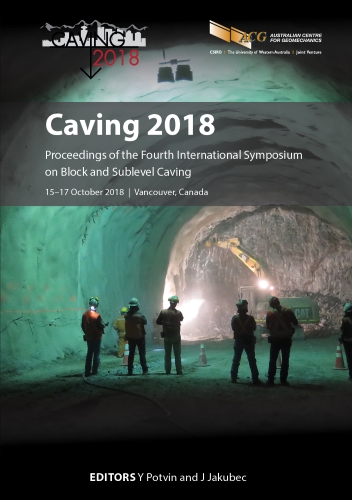Using a structured data management system to improve mine development efficiencies

|
Authors: Savage, E; Moorcroft, T; Talu, S |
DOI https://doi.org/10.36487/ACG_rep/1815_61_Moorcroft
Cite As:
Savage, E, Moorcroft, T & Talu, S 2018, 'Using a structured data management system to improve mine development efficiencies', in Y Potvin & J Jakubec (eds), Caving 2018: Proceedings of the Fourth International Symposium on Block and Sublevel Caving, Australian Centre for Geomechanics, Perth, https://doi.org/10.36487/ACG_rep/1815_61_Moorcroft
Abstract:
A structured data management system has shown measureable improvements during two years of data capture, management, and analysis at the Oyu Tolgoi underground mine. This has directly led to enhanced contractor relationships between the mining contractor and the owners team, and underground development quality. CaveCad is an integrated data capture and storage system for capturing underground block caving related data. The CaveCad system has been used in conjunction with detailed data capture, through laser scanning of every excavated development round. This is undertaken immediately after mucking and then again directly following the installation of ground support. This results in detailed 3D asbuilts which are used for measuring a number of quality control metrics including resin encapsulated rebar and cable bolt spacing, mesh overlap, shotcrete thickness, and excavation compliance to design. The data collected from this process is used for tracking compliance to both excavation and ground support design, and, where required, rectification of issues by the contractors when installations are non-compliant. In the past, serious safety incidents have occurred in the mining industry due to a lack of detailed understanding of the true as-built of the mine, along with a lack of understanding of the history, location, and quality of installed ground support material. The strategy of keeping a specific team for data management and analysis was directly related to the decision to laser scan all blasted headings underground, to mitigate these potential risks and knowledge gaps, and to ensure high-quality usable data is available throughout the mine life. A detailed 3D as-built plan is available for both the excavation and installed ground support, which can be referenced at all times by all mining personnel. The results of this detailed data capture show improvements over time in both quality and efficiency of the mining process. This includes a reduction of shotcrete overspray and over-bolting issues and a marked decrease in excavation overbreak from the designed tunnel profile, resulting in an increase in compliance to excavation design. This has enabled Oyu Tolgoi to improve accuracy of mining, quality of the ground support installation, reduction in wastage (e.g. shotcrete), and improved, better informed discussions with contractors regarding key performance indicators that incentivise them. High-quality and qualitative data management has also allowed for fast and reliable data sharing between stakeholders, reducingany potential knowledge silos and enabling improvements to be made to the mining cycle based on actual lessons learned.
Keywords: data management, contractor management, laser scanning, geotechnical data, quality control, CaveCad, reporting
References:
Oyu Tolgoi LLC 2016, Oyu Tolgoi Underground Feasibility Study, Oyu Tolgoi LLC, Ulaanbaatar.
Savage, E, Talu, S, Sturm, P & Van As, A 2016, ‘Development and implementation of the CaveCad ground support module for cost and safety improvements in block cave mines’, Proceedings of MassMin 2016, The Australasian Institute of Mining and Metallurgy, Melbourne, pp. 769–772.
Zoller + Froehlich GmbH 2018, Z+F Imager 5010C Datasheet, Zoller + Froehlich GMBH Wangen im Allgäu, viewed 8 August, 2018,
© Copyright 2025, Australian Centre for Geomechanics (ACG), The University of Western Australia. All rights reserved.
View copyright/legal information
Please direct any queries or error reports to repository-acg@uwa.edu.au
View copyright/legal information
Please direct any queries or error reports to repository-acg@uwa.edu.au
